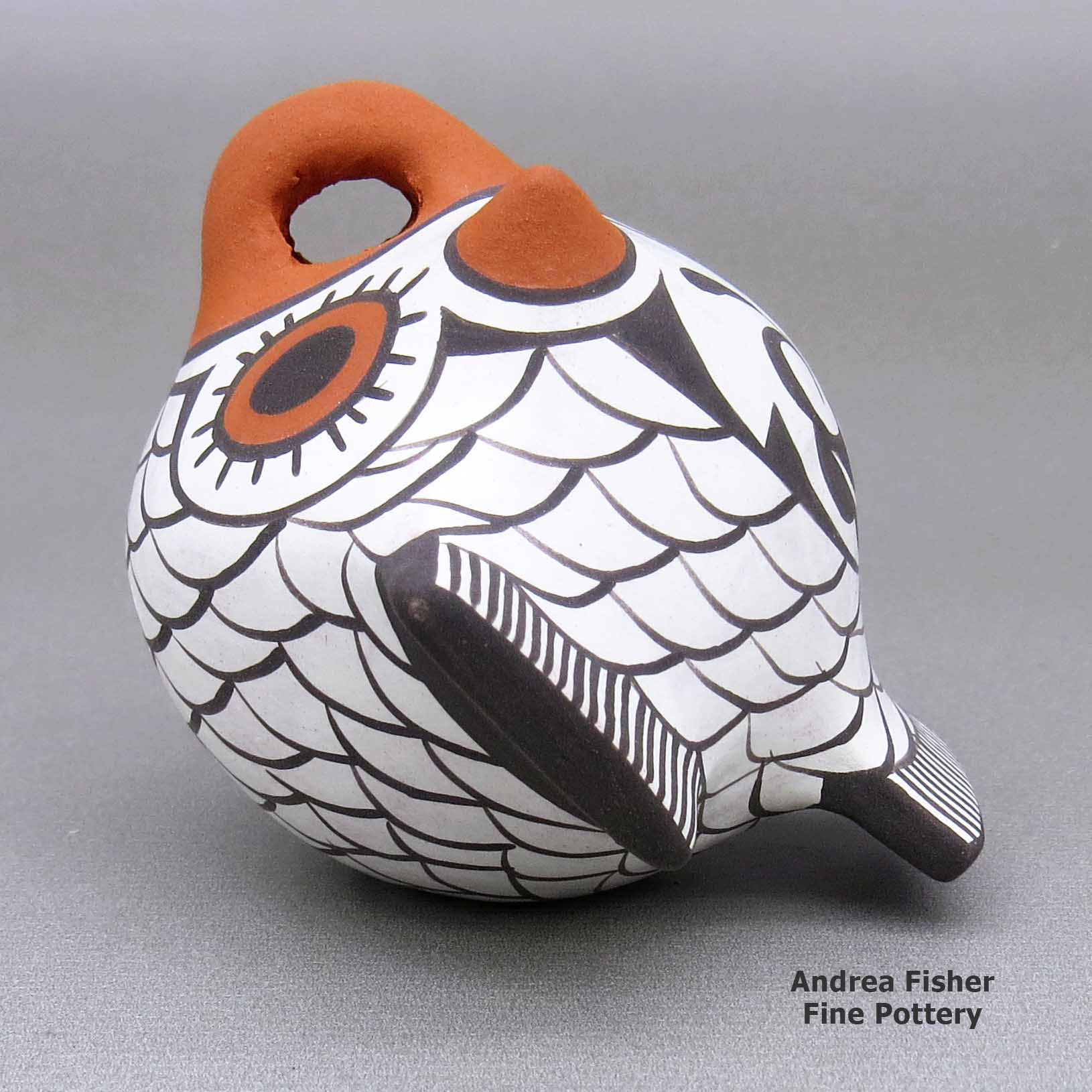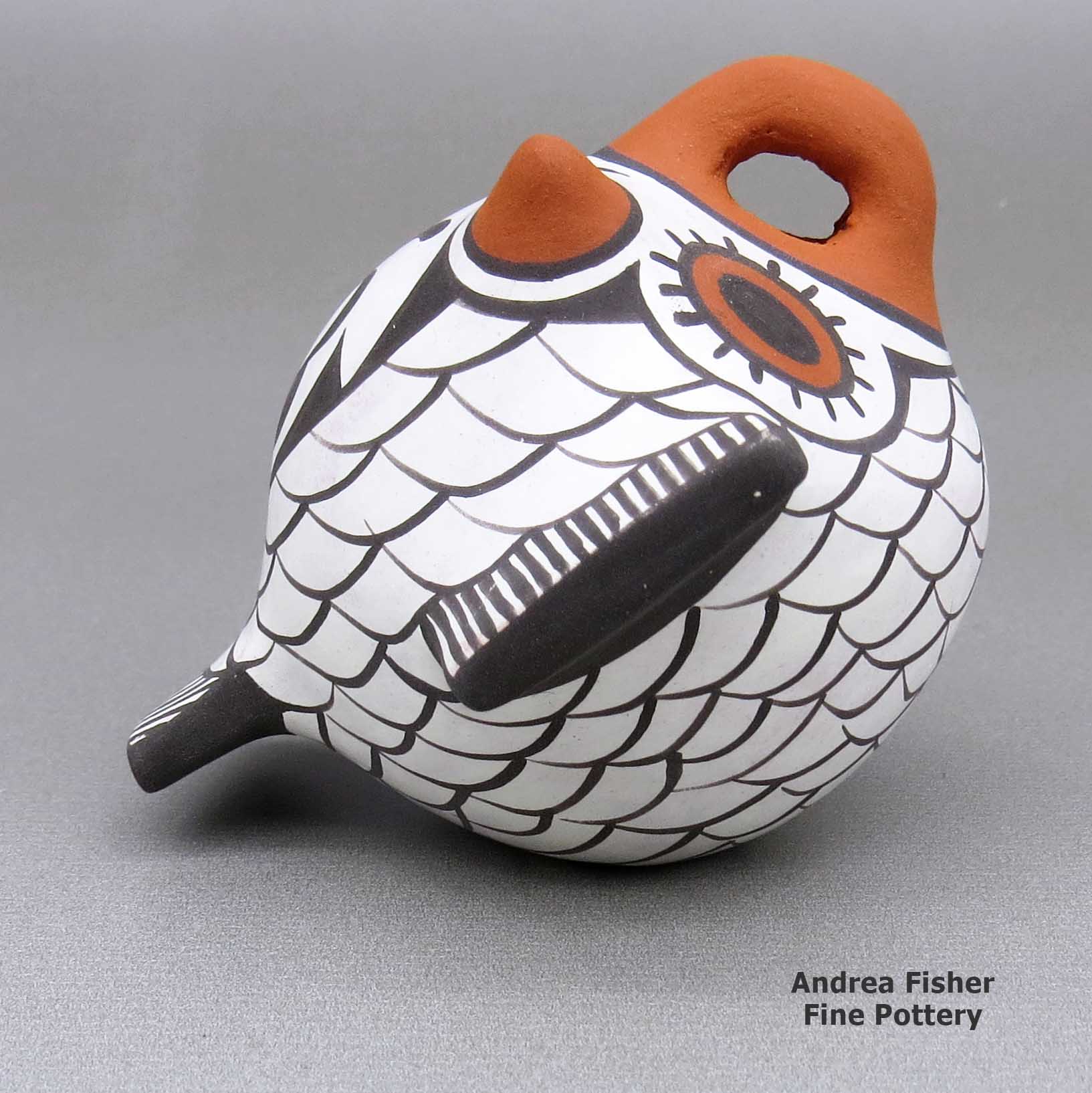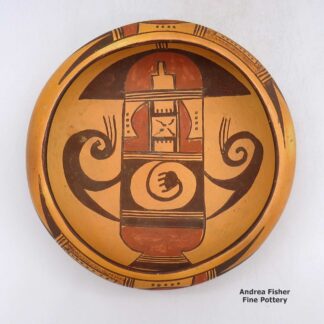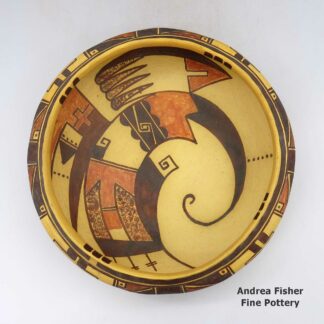| Dimensions | 2.25 × 3 × 2.5 in |
|---|---|
| Condition of Piece | Excellent |
| Signature | Avelia Anderson .J. Peynetsa Zuni, with copyright symbol |
| Date Born | 2023 |
Anderson Jamie Peynetsa, zzzu3b072m1, Small polychrome owl figure
$165.00
A small polychrome owl figure
In stock
- Product Info
- About the Artist
- Home Village
- Design Source
- About the Shape
- About the Design
- Teaching Tree
Brand
Peynetsa, Anderson Jamie
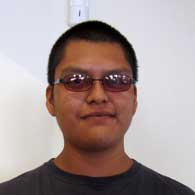 Anderson Jamie Peynetsa is the son of Anderson and Avelia Peynetsa, nephew of aunts Agnes Peynetsa and Priscilla Peynetsa. He was born at Zuni Pueblo in 1997.
Anderson Jamie Peynetsa is the son of Anderson and Avelia Peynetsa, nephew of aunts Agnes Peynetsa and Priscilla Peynetsa. He was born at Zuni Pueblo in 1997.Jamie's been making pottery since he was 11 years old, learning from his brother, his father and at Zuni High School. He participated in his first show in 2008, the Santa Fe Indian Market, and earned a First Place ribbon in the Junior Pottery Division. In 2018 he earned a First Place ribbon at the Heard Museum Guild Indian Art Fair & Market for a large traditional Zuni jar with a traditional geometric design.
Jamie's favorite shapes are either contemporary (he sometimes makes duck pots) or traditional Hawikuh-Revival styles. His favorite designs are a mix of modern fine line and traditional Zuni designs.
He says he gets his inspiration from his father and his goal is to learn all he can from his dad and produce pots at least as good as his. For the last several years Jamie has been working more with his mother, Avelia. She makes some of the pots that he paints.
Avelia is the great-granddaughter of Catalia Zunie, the woman who recruited Daisy Hooee to teach traditional pottery-making classes at Zuni High School in the 1960s.
A Short History of Zuni Pueblo
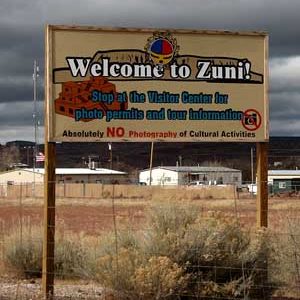
"K'ynánas'tipe stretched his legs to the four great seas, then gradually he settled down and called out, 'where my heart and navel rest, beneath them mark the spot and build your town there for that shall be the midmost place of Mother Earth.' As he squatted over the middle of the plain and the valley Zuni, he drew in his legs and his feet marked the trails leading outward like the radiating web of a spider. The fathers of the people built on this spot and rested their fetishes there." - Frank H. Cushing, Outlines of Zuni Creation Myths, pp. 428-9
Archaeologists have dated some sites on the Zuni Reservation back to the Paleo-Indian Period, more than 4,500 years ago. During the Archaic Period (2,500 BCE to 0 CE), the forebears of the Zuni were hunter-gatherers and just beginning to develop agriculture. The Basketmaker Period (0 CE to 700 CE) saw agriculture become more developed and the Zunis make their first pottery. The Pueblo I Period (700 CE to 1100 CE) saw an expansion of the population and larger settlements were built in the Zuni River area along with the development of the first painted Zuni pottery.
The Pueblo III Period (from 1100 to 1300 CE) saw further population growth in the Zuni River area and a shift from small houses to larger, plaza-oriented villages. The Pueblo IV Period (1300 to 1500 CE) was the time of significant bad weather, great drought and the beginning of the flood of Athabascans and Utes. Many tribal groups were forced out of the Four Corners area and relocated to locations near the Rio Grande, Rio Puerco, Zuni River and Little Colorado River. The main Zuni Pueblo was founded during this time but there were several other large villages in the area, too.
In 1540 Francisco Vasquez de Coronado arrived at the gates of Hawikuh, at the time one of the larger of seven Zuni pueblos. He first approached the pueblo at the end of a four-day religious festival. The Zuni chief had spilled a line of corn meal across the ground before the entrance to the pueblo, meant to signify to the Spanish that they shouldn't cross the line and enter the village yet. Coronado interpreted that line of corn meal as an act of war and immediately ordered his soldiers to attack.
Coronado was almost killed in the fighting (Zuni warriors had dropped a large rock on him, knocking him off his ladder and almost crushing him) but his soldiers did finally win the battle. As Coronado and his men brought horses and sheep with them, they were probably the first such livestock the Zunis had ever seen. The gold the Spaniards were looking for: it turned out to be Sikyátki Polychrome bowls and jars, yellow clay gifts from the Hopi people to the Zuni people.
The Zuni chief did give Coronado a refugee from the Plains tribes, someone who'd somehow made his way as a lone traveler to Hawikuh. That refugee was supposed to be a guide for Coronado and his men but he was instructed by the Zuni chief to take Coronado into the Plains and get him lost there. When Coronado finally realized that, more than a year later, he ordered the guide executed, then turned his men around and headed back to Zuni and Mexico.
When he passed by Zuni in 1542, Coronado left three Mexican Indians behind with the tribe. They most likely informed the tribal leaders of the extent of the Spanish domain in Mexico and the power they exercised there.
Except for a couple passing exploratory expeditions, the Zuni pueblos were left alone until the 1620s. Then came the friars who oversaw the construction of a mission church at Hawikuh in 1629. At first the Zuni people were friendly with the priests but with the forced labor requirements and forced religious conversions, the priests wore that welcome out quickly. Relations had changed drastically for the worse by the time of the Pueblo Revolt of 1680. Zuni warriors killed the priests and burned the missions but they preserved the relics and icons the priests had brought from Spain.
The tribe built a village near their fortress atop Dowa Yalanne and prepared to defend their people and way of life against the Spanish army. When Don Diego de Vargas arrived with troops in 1692, he attacked the fortress twice and failed. Then he negotiated with the Zuni war chief and was allowed to ascend to the top of Dowa Yalanne. He was given a tour of the property and he found many relics from the destroyed missions there. With that knowledge, he arranged a peace between the Spanish and the tribe. Between 1693 and 1700 the tribe consolidated all their small villages into what is now the Pueblo of Zuni.

Photo courtesy of Ken Lund, Creative Commons Attribution-Share Alike License 2.0 Generic
Traditional Zuni Designs
Anthropologists say the Zuni people have been isolated for so long, there are no referrents to where their language came from. The images they paint on pottery, though, show some signs of cross-pollination with the Hopi, Acoma, Laguna and some of the Rio Grande pueblos.
Among those images are the heart-line, as in deer-with-heart-line. At some pueblos, that has become bear-with-heart-line and antelope-with-heart-line. Sometime around 1890, a Laguna potter made the journey to Zuni to learn from a potter there how to make better pottery. He stayed only a few months before returning to Laguna, via Acoma. He brought back better knowledge of mixing the clay, making the paints and painting the designs. Among those designs was the deer-with-heart-line.
At the time of first Spanish contact, there were seven Zuni pueblos spread out along the Zuni River. By about 1720, that was reduced to one. When the American archaeologists arrived, they set about excavating almost every abandoned village they could find. In the process, many pieces of ancient pottery came to light. That's where the names Matsaki Polychrome and Red-on-buff (matte paint on white and red slips, produced from about 1375 CE to about 1700 CE), Kwakina Polychrome (glaze paint on a white slip, produced from about 1325 to about 1400) and Heshotauthla Black-on-red and Polychrome (glaze decorations, produced from about 1275 to about 1400) came from. A primary difference between Kwakina and Heshotauthla designations is the color the inside of the bowl is slipped with. The decorations on both are painted with lead glaze colors and are taken from the same design library, which includes many designs common to the Mogollon Highlands in eastern Arizona (such as St. Johns Polychrome), although the designs tend to be not as well executed.
The advent of Matsaki Polychrome and Red-on-buff coincides with the entrance of an immigrant community from the north: the land of the Hopi. With them came the basic design library of what we now refer to as "Sikyatki Polychrome." Production of Kwakina- and Heshotauthla-style pottery dropped off quickly after the arrival of those who produced the Matsaki styles. It was around that time, too, that the Zuni villages around the Zuni Mountains were abandoned and the people pulled back to the pueblos along the lower Zuni River.
After Spanish contact and conquest, the Zunis were reduced to about one-tenth their population by Spanish diseases and labor practices. Before too long, they were gathered together in one village near the bank of the Zuni River. Their image catalog changed, too. When the American archaeologists and ethnologists came, they removed virtually every artifact of Zuni history they could dig up or find otherwise. Then they spirited it all away to storerooms on either coast, where most of it remains in boxes in dingy basement rooms today.
In 1986, Josephine Nahohai and several members of her family traveled to Washington DC and explored the basement storage shelves of the Smithsonian Institute, copying every ancient Zuni shape and design they found into their notebooks. When they returned to Zuni, their drawings became the basis for many of what are now referred to as traditional Zuni designs. Among those designs are symbols for mountains and forest, and images of frogs, tadpoles, dragonflies, serpents and rainbirds. Other Zuni potters have since visited other storerooms of ancient Zuni pottery and brought drawings of those shapes and designs back to the pueblo, too.
About Effigies
An effigy is a sculpture or model of an animal or person. Effigies have a long history among southwestern Native Americans. Effigies include everything from pottery that explicitly resembles a human or an actual animal to pottery that only references a part or parts of a human or an animal in its shape to creations of creatures that are absolutely wild and whimsical.
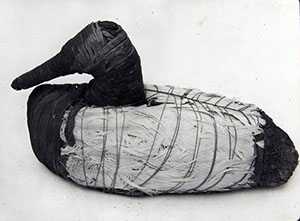
In Nevada, near the Humboldt Sink (where the Humboldt River disappears into the desert sands), a group of guano miners working in Lovelock Cave in 1911 exposed some ancient artifacts while they were digging. Shortly after the miners left, some archaeologists arrived and started poking around and digging, too. They weren't much better educated in the practices of archaeological digging than the guano miners were but they did save almost everything they found. It was more than a decade after those archaeologists investigated the cave that other archaeologists dug a bit deeper in the back of the cave and found a bundle of eleven duck decoys, all woven of local reeds more than 2,300 years ago. Some were painted, some were decorated with feathers, some weren't finished yet.
Effigies have been found in Mayan ruins, Aztec ruins, the ruins of Teotihuacan, the ruins near Valdivia in Ecuador, the ruins of the pyramid-building cultures in Peru and ruins near the Caribbean coast in Colombia. There were many effigies found in the ruins of Paquimé, too.
Photo of the duck decoy courtesy of the Autry Museum, CCA-by-SA 3.0 License.
About Bird Elements
One of the main tenets of the Flower World ideology is that birds are messengers to and from Paradise. They carry our prayers to Heaven and they bring back the responses. Not all the pueblos accepted the Flower World ideology but it seems almost everyone, almost everywhere, agrees that birds are the messengers of Heaven. All pueblos do have multiple designs that incorporate feathers, if feathers aren't the main element of the design.
The Flower World ideology originated in central Mexico and most likely traveled north to the pueblos in the company of missionaries and long-distance traders. Turquoise was taken south while tropical birds, copper bells, seashells, and textiles (with particular spiritual designs on them), along with other spiritual items, were taken north. Going either way, almost everyone passed by Paquimé. The trade routes from the south came together there and the trade routes to the north diverged from there. That business didn't really come together until the first structures went up in the immediate vicinity of Paquimé, around 1150 CE. Then it ended around 1450 CE when the city was abandoned. That was also the end of pilgrims making their way south and then coming north again a few years later. For more than 300 years that traffic had been a major profit center and prestige generator for the people of Paquimé and Casas Grandes. After Paquimé was abandoned, though, the trade and pilrimage routes became far more dangerous. With the advent of the Aztec Empire in central Mexico, being a foreigner in that area became far more dangerous, too. Essentially, the puebloans who had embraced the Flower World ideology were cut off from their Holy Land.
The Flower World Complex, with its symbology, flowed across the American Southwest and eventually reached the Four Corners area. But it arrived at about the same time the kachina cults were coming together and the people were abandoning the Four Corners. The Flower World ideology was felt to be greater than what had come before so it's symbology was basically imprinted on top of that. Then the designs of the kachina cults and other clans were added on top of the Flower World symbology. Then came the Europeans with their designs and spiritual practices.
One of the principals of Native American design is that it is necessary only to note one part of most animals to imply the presence of the whole, especially when it comes to birds and bird elements. A lot of the design on Hopi pottery can only be described as "bird elements," although it is often possible to discern parrot feathers from eagle feathers, and eagletails from other bird's tails.
The Zunis have an ancient "almost-spiral" design that comes from the beaks of their equally ancient "rainbirds." The Zunis also like to make owl figures as owls are a symbol of wisdom to them. To some Northern Tewas, owls are creatures to be feared.
At Acoma they have a "cloudeater," a crane pictured with neck bent over and filling with fish shown sideways in its throat as it swallows them whole. Acoma potters also have a parrot that resembles the parrot found on the sides of the boxes carried by Amish traders back in the day. The parrot is not complete without a branch with leaves, and maybe berries, in its claws.
At Santo Domingo, religious dictates limit what can be imaged on pottery offered to the public. Birds, fish, turtles and flowers are allowed, along with a vast catalog of geometric designs. Images of humans are not. Next door at Cochiti, almost anything goes
The artists of the Mata Ortiz area are resurrecting some of the designs left behind by artists of old but they have no inner connection with the Flower World. Others in today's Mata Ortiz have gone totally contemporary: carving, scratching and painting beautiful images of birds with branches, vines and flowers.
Zuni Pueblo Teaching Tree
Disclaimer: This "teaching tree" is a best effort on our part to determine who the potters are in this group and arrange them in a generational order.
The pottery tradition at Zuni Pueblo almost died out until Daisy Hooee (granddaughter of Nampeyo of Hano, Hopi-Tewa) took on the job of teaching pottery at Zuni High School in 1960. She was recruited for the job by Catalina Zunie, a Zuni potter who had spent several years just trying to get pottery on the school curriculum. Daisy also spent a year working with Catalina to become a consummate Zuni potter herself before she started teaching.
There have been several teachers at Zuni High since then and for some students, learning from their parents (who were former Zuni High students) has helped to strengthen the tradition. This diagram is subject to change should we get better info.
- Daisy Hooee Nampeyo taught 1960-1974
- Jennie Laate taught 1974-1990
- Carlos Laate
- Agnes Peynetsa
- Anderson Peynetsa & Avelia Peynetsa
- Anderson Jamie Peynetsa
- Ashley Peynetsa
- Dominic Laweka
- Priscilla Peynetsa & Daryl Westika
- Daria Westika
- Gaylon Westika
- Caylon Westika
- Brian Tsethlikai and Yvonne Nashboo
- Eileen Yatsattie

